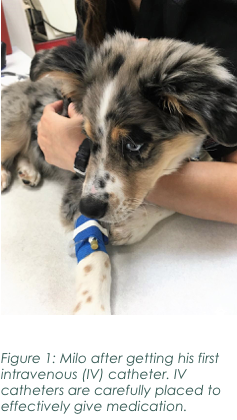Milo Eats A Penny
Written by Elizabeth M. • 2017 Scholar
History

On June 22nd 2017, Milo, a three month old Australian Shepherd, came to IVS due to diarrhea, lethargy, vomiting, and gagging up blood. Dr. Karl Bolser examined Milo and found some abnormalities with his respiration and abdomen. There were slightly increased lung sounds and Milo was having some difficulty inspiring air. Milo’s abdomen was also painful.
Diagnosis Plan
To help determine why Milo was sick, the pup had selected blood tests and radiographs.
Blood Tests
Blood can be used in a multitude of ways to evaluate a patient’s health status. One such way is a simple blood test that indicates whether a dog is positive for the disease, Parvo. Blood electrolytes, chemistry, composition, and clotting times were all evaluated too. Technicians double check all blood results by creating blood smears evaluating the blood using a light microscope.
Milo’s Blood Test Results:
- Parvo--- negative
- Complete Blood Count--- Mature neutrophilia
- Chemistry Panel--- mildly elevated GGT liver enzyme
- PT/PTT--- slightly prolonged PTT clotting time
Radiographs
Commonly referred to as “x-rays”, radiographs are a common diagnostic tool veterinarians use to view internal structures. Milo had radiographs of both his thorax (chest region) and abdomen. Dr. Bolser was able to see brighter interstitial patterns within the right middle and right caudal (lower) lung lobes, suggesting fluid or inflammatory cells in the lungs. A metallic foreign body shaped like a coin was also seen within the stomach.
Diagnosis
Ingestion of a foreign body likely leading to aspiration pneumonia. Milo probably ate a coin but was unable to pass it normally, causing diarrhea and vomiting. He may have inhaled some vomit causing fluid in the lungs.
Treatment Plan
Dr. Bolser recommended surgery to remove the foreign body. Milo’s owners gave their consent and a gastrotomy was performed that night, removing a penny within the stomach. Milo was hospitalized for a couple of nights and received fluids, pain medication, and antibiotics. Every 4 hours he received nebulization and coupage therapy to help loosen debris and encourage him to cough the material out of his lungs. While hospitalized, Milo’s fecal test results came back positive for roundworms, so he received oral dewormer. Two weeks after surgery, Milo had his abdominal staples removed.
Zinc Toxicosis: Since the foreign body was a penny, zinc toxicity could have become an issue for Milo. Pennies made since 1983 contain zinc. Zinc is also found in some hardware items, shampoos, paint, calamine lotion, and suppositories. Zinc toxicosis causes acute hemolysis, or destruction of red blood cells resulting in anemia.
Today: As of July 2017, Milo has been recovering great and acting like his normal puppy self. Thank you to Milo’s family for allowing me to share this presentation with IVS and ISU. He was such a sweet, happy boy!
References & Citations
Plunkett SJ. Emergency Procedures for the Small Animal Veterinarian. 2001. Page 397.


